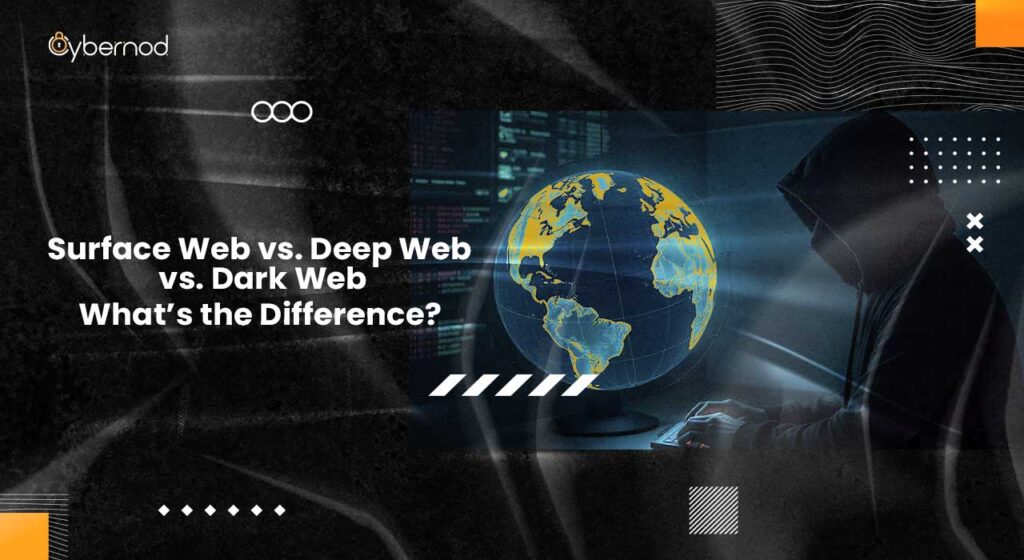
The internet is an extensive network, though only a limited portion is accessible to the majority of users. While we navigate websites and perform searches on what’s known as the Surface Web, there exists an entire hidden side of the internet—often segmented into the Deep Web and the more elusive Dark Web. This guide unpacks these layers, explaining the unique characteristics and purposes of each.
1. The Surface Web: What’s Visible
The Surface Web, sometimes called the “open” web, is the internet layer familiar to most people. Think of it as the accessible, public-facing portion of the internet, comprising websites that search engines can crawl and index. This layer includes news websites, social media platforms, and virtually all pages that end with recognizable domain suffixes like “.com” or “.org.”
Despite its accessibility, the Surface Web actually represents a fraction of the total web—often estimated to be less than 5%. The rest lies beneath the surface, away from traditional search engines.
2. The Deep Web: The Vast Hidden Network
Moving below the Surface Web, we enter the Deep Web. Unlike the open, searchable content on the Surface Web, the Deep Web includes pages that are not indexed or searchable by standard search engines like Google. This layer consists of private databases, login-protected sites, academic records, financial data, and many other resources concealed behind firewalls, passwords, or other access restrictions.
Much of what we do online like online banking, viewing email, or accessing private business portals happens within the Deep Web. Although it is often viewed as mysterious, the majority of the Deep Web is lawful and secure. It’s protected mainly to maintain user privacy and data security.
3. The Dark Web: The Hidden Underbelly
At the deepest layer lies the Dark Web, a section of the Deep Web that is intentionally hidden and requires special tools like the Tor browser to access. Unlike the broader Deep Web, the Dark Web consists of websites with encrypted content that prioritize anonymity and privacy. They typically use the “.onion” domain suffix and aren’t accessible through conventional browsers.
The Dark Web is often associated with illicit activities due to its high level of anonymity. Here, users can find both legal and illegal content, ranging from marketplaces for digital privacy and anonymity tools to sites that host illegal goods and services.
Why People Use the Dark Web

The anonymity afforded by the Dark Web presents both advantages and drawbacks. While it attracts people seeking protection from surveillance (such as whistleblowers, journalists, and activists), it also serves as a haven for less lawful activities. Cybercriminals use the Dark Web to sell stolen data, malware, and illegal substances. However, this doesn’t mean that accessing the Dark Web is inherently illegal. The way it’s used often determines whether it crosses legal boundaries.
Is Accessing the Dark Web Safe or Legal?
Using the Dark Web is generally legal in most countries, but users need to exercise caution. Tor and similar networks are not illegal; however, some activities on the Dark Web may be, such as viewing or participating in illegal marketplaces. Even visiting these areas can expose users to scams, malware, and tracking by law enforcement agencies.
Safety Tips for Exploring Beyond the Surface Web
For those interested in exploring the darker corners of the web, certain precautions are necessary:
- Use robust security measures: Ensure your device has up-to-date antivirus protection.
- Use a separate online identity: Avoid linking personal information to accounts or transactions on the Dark Web.
- Limit downloads and interactions: Many files on the Dark Web are laden with malware.
- Avoid financial transactions: Scams are common, and money sent is rarely recoverable.
- Stay anonymous: Never share identifying information, and consider using a VPN for an added layer of protection.
Navigating the layers of the internet beyond the Surface Web can be risky without the right tools and expertise. At Cybernod, we specialize in dark web monitoring and cybersecurity solutions designed to keep your data and privacy secure. If you’re curious about safeguarding your business from hidden online threats, visit Cybernod’s site for more information on how we can help protect what matters most.
For a deeper dive into securing your online presence, especially in the age of cloud computing, check out our article on “Integrating Cloud Security with Traditional Cybersecurity Approaches”.
Final Thoughts
Understanding the difference between the Surface Web, Deep Web, and Dark Web can enhance internet literacy and safety. While the Dark Web may seem intriguing, it’s a space that requires caution and discretion. For most users, the Surface and Deep Web contain more than enough resources for secure online experiences.
Categorized in:
Tagged in:
AI, cloud security, Cybernod, cybersecurity, Dark Web, Dark Web Monitoring, Deep Web, InternetSafety, OnlinePrivacy, Surface Web
Comments